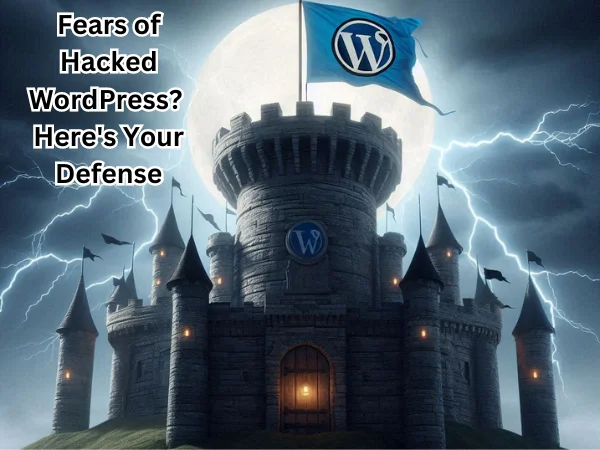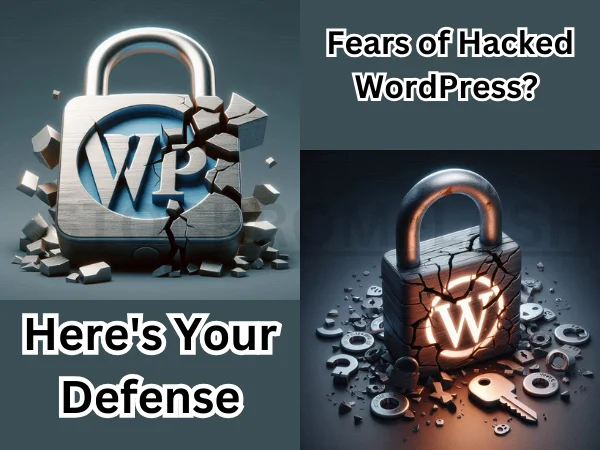Don’t Let Hackers Crash Your WordPress Party: A Guide to Security

Ever poured your heart and soul into building a beautiful WordPress website, only to have the fear of hackers looming in the back of your mind? You’re not alone. WordPress, with its vast user base and the plethora of plugins, is a prime target for attackers.
Recently, a critical vulnerability (CVE-2024-27956) emerged in the popular WP-Automatic plugin, allowing hackers to completely take over websites using a technique called SQL injection. This could mean stolen data, embarrassing website defacement, or worse.
But fear not, WordPress warriors! We’ll delve into the WP-Automatic vulnerability, explore common WordPress security threats, and most importantly, provide actionable steps to fortify your website. By the end of this post, you’ll have the confidence to banish those security anxieties and keep your WordPress site thriving!
Understanding the Threat: The WP-Automatic Vulnerability
Many WordPress users rely on the WP-Automatic plugin to streamline their content creation workflow. This nifty tool automates the process of importing content like text, images, and videos from various online sources and publishing it directly on your website. Sounds convenient, right?
Unfortunately, a recent vulnerability in WP-Automatic (CVE-2024-27956) exposed a serious security risk. This vulnerability falls under the category of an SQL injection (SQLi) attack. Here’s how it works:
Imagine your website’s database as a locked vault holding all your important information. An SQLi attack exploits a weakness in the plugin’s security to inject malicious code, acting like a skeleton key for hackers. This code can then manipulate the database, potentially allowing attackers to:
- Gain Administrator Access: Once inside the vault, hackers can create new administrator accounts, granting them complete control over your website.
- Steal Sensitive Data: They could steal valuable information like user passwords, customer details, or even your website content.
- Deface Your Website: Imagine your website displaying a nasty message instead of your carefully crafted content. Hackers can use this vulnerability to deface your website, causing embarrassment and reputational damage.
The good news? A patch has been released! Version 3.92.1 of WP-Automatic addresses this vulnerability. Updating your plugin immediately is crucial to prevent your website from falling victim to an attack. Don’t wait! Patch now, and keep your website safe!
Beyond WP-Automatic: Common WordPress Security Threats to Watch Out For
While the WP-Automatic vulnerability serves as a stark reminder, it’s just one piece of the WordPress security puzzle. Here are some other common threats that can put your website at risk:
Outdated Software: A Chink in Your Armor
Just like that leaky roof, you keep trying to fix, outdated WordPress software (core, themes, and plugins) creates vulnerabilities that hackers can exploit. These outdated versions often lack security patches that address known weaknesses. Regular updates are essential to ensure your website has the latest security protections in place.
The Password Problem: Why Strength Matters

Imagine using a flimsy padlock to secure your treasure chest. That’s what weak passwords do for your website. Hackers employ various techniques, like “brute-force attacks,” to guess passwords. These attacks involve systematically trying millions of password combinations until they crack the code.
The solution? Strong, unique passwords are your best defense. Use a combination of uppercase and lowercase letters, numbers, and symbols.
Brute Force Attacks: Bolstering Your Defenses
Brute-force attacks may sound intimidating, but there are ways to fight back. Many WordPress security plugins offer features like login attempt limitation. This functionality restricts the number of times someone can attempt to log in within a specific timeframe. After exceeding the limit, the plugin temporarily blocks the IP address, making it much harder for hackers to crack your password through brute force.
Malicious Plugins: Not All Shine What They Seem
Free plugins can be tempting, but some might be wolves in sheep’s clothing. These malicious plugins, often disguised as legitimate tools, can be designed to steal your data or inject malware onto your website. Malware can then redirect visitors to malicious websites, steal sensitive information, or disrupt your website’s functionality.
To stay safe, only install plugins from reputable sources like the official WordPress plugin directory or well-established developers. Read reviews and ratings before installing, and avoid plugins with minimal downloads or negative feedback.
Cross-Site Scripting (XSS): When Code Takes a Nasty Turn
- Cross-site scripting (XSS) attacks involve injecting malicious scripts into your website. These scripts can then be used to steal user data, redirect visitors to phishing sites, or deface your website.
- XSS attacks often target vulnerabilities in themes and plugins. Keeping your software updated is crucial to prevent these vulnerabilities.
Stay tuned for the next section, where we’ll delve into actionable steps you can take to fortify your website and keep the bad guys at bay!
Fortifying Your WordPress Fortress: Best Security Practices
Now that you’re armed with knowledge about common WordPress security threats, let’s get your website into lockdown mode! Here are some actionable steps you can take to significantly improve your website’s security posture:

Update Regularly: Your Website’s Security Shield
Think of updates as security patches for your website. They address vulnerabilities that hackers might try to exploit. Here’s the key:
- Update Everything: Regularly update your WordPress core, themes, and plugins. These updates often include critical security patches, so don’t delay!
- Enable Automatic Updates: Most WordPress themes and plugins offer automatic update functionality. Navigate to the plugin or theme settings and enable automatic updates for peace of mind. For WordPress core updates, you can choose between automatic background updates (recommended for most users) or manual updates via the dashboard.
Strong Passwords: Your First Line of Defense
Imagine a website secured with a flimsy “password123.” Not exactly Fort Knox, right? Here’s why strong passwords are crucial:
- Complexity is Key: Use a combination of uppercase and lowercase letters, numbers, and symbols. The longer and more complex, the better.
- Uniqueness Matters: Avoid using the same password for multiple accounts. If one website gets compromised, hackers might try your login details elsewhere.
- Password Managers to the Rescue: Consider using a password manager. These tools generate and securely store strong, unique passwords for all your online accounts.
Two-Factor Authentication (2FA): Double the Security
Think of 2FA as an extra security checkpoint. Here’s what it does:
- Adding an Extra Layer: In addition to your password, 2FA requires a secondary verification code, typically sent to your phone via SMS or generated by an authenticator app. This makes it much harder for hackers to gain access, even if they crack your password.
- Enabling 2FA in WordPress: Luckily, enabling 2FA in WordPress is easy. Many security plugins offer this functionality, or you can explore third-party authentication services like Google Authenticator.
Security Plugins: Your Security Arsenal
Think of security plugins as additional security guards patrolling your website. Here’s how they can help:
- Monitoring Login Attempts: Security plugins can monitor login attempts and block suspicious activity. This can prevent brute-force attacks where hackers try to guess your password repeatedly.
- Malware Scanning and Protection: Some plugins offer malware scanning features that can detect and remove malicious code injected onto your website. This can protect your visitors from phishing attempts or data theft.
- Firewall Functionalities: Firewalls act as a barrier, filtering incoming traffic and blocking malicious requests before they reach your website.
User Permissions: Granting Least Privilege
Imagine giving everyone a master key to your website. Not ideal, right? Here’s how user roles work:
- Minimum Permissions: Assign only the minimum necessary permissions to each user role (administrator, editor, author, subscriber). For example, an author only needs permission to write and edit their own posts.
- Understanding User Roles: An administrator has full control over the website, while an editor can publish posts but not manage users. Authors can create and edit their own posts, and subscribers can only manage their profiles.
Limited Login Attempts: Stop Brute-Force Attacks in Their Tracks
Remember those brute-force attacks? Here’s how to limit them:
- Limiting Login Attempts: WordPress settings allow you to limit the number of login attempts permitted within a specific timeframe. If someone exceeds the limit, their IP address gets temporarily blocked. This significantly reduces the risk of a successful brute-force attack.
Backups: Your Website’s Safety Net
Even with the best security measures, unforeseen events can occur. Here’s why backups are essential:
- Disaster Recovery: Regular backups create a copy of your website that can be restored in case of a security breach, accidental data loss, or server malfunction.
- Backup Plugins and Strategies: Many plugins automate backups and schedule them to run regularly. Consider storing backups in a secure location, like a cloud storage service, in addition to a local copy.
Staying Vigilant: Monitoring and Responding to Threats
Just like a good security system, maintaining vigilance is crucial for your WordPress website. Here’s how to stay on top of potential threats:
- · Security Plugin Alerts: Many security plugins offer real-time monitoring and send alerts for suspicious activity, such as failed login attempts from unknown locations or unusual changes to your website files.
- · Reviewing Website Logs: Regularly review your website logs for any unusual activity. These logs record events like login attempts, errors, and plugin activity. Look for any suspicious entries, like repeated failed login attempts or errors related to unknown files.
what if the worst happens, and your website is compromised?
Don’t panic! Here’s how to respond:
- · Swift Action: Take immediate action to contain the breach. Change all your WordPress passwords, including administrator and user accounts. Isolate any infected files identified in the logs to prevent further damage.
- · Seeking Professional Help: For complex security breaches, consider seeking assistance from a security specialist. They have the expertise to diagnose the extent of the damage, remove any malicious code, and restore your website to a secure state.
By staying vigilant and having a response plan in place, you can minimize the damage caused by a security breach and get your website back online quickly.
Frequently Asked Questions About WordPress Security
· How often should I update my WordPress plugins?
Ideally, you should update your WordPress plugins as soon sollen (as soon as possible) after updates become available. Many plugins offer automatic update functionality, so enabling that is a great way to stay on top of the latest security patches.
What are some signs my website might be hacked?
Here are some red flags to watch out for:1. Slow website performance: A sudden decrease in website speed could indicate malicious code is bogging down your site.
2. Unexpected changes: Did your website content or layout change unexpectedly? This could be a sign of hacker tampering.
3. Suspicious activity in website logs: Look for repeated failed login attempts or errors related to unknown files.
4. Security software alerts: If you’re using a security plugin, pay attention to any alerts it generates.
find a reputable security expert to help you?
Many web hosting companies offer security services. Additionally, online marketplaces like Upwork or Fiverr allow you to connect with freelance security specialists. When choosing a security expert, look for positive client reviews and experience working with WordPress websites.
By following these tips and staying informed, you can significantly improve your WordPress website’s security posture and ensure your online presence remains a safe haven for you and your visitors.
Your WordPress Fortress Awaits!
WordPress security might seem daunting, but by taking proactive measures, you can transform your website into a well-defended fortress. Implement the security practices outlined in this guide, from keeping your software updated to utilizing strong passwords and security plugins. Remember, vigilance is key! Monitor your website and have a response plan in place for potential threats.
For further information on WordPress security, explore resources provided by the official WordPress website and reputable security plugin developers. With a commitment to security, your WordPress website can thrive and remain a secure space for you and your visitors.






